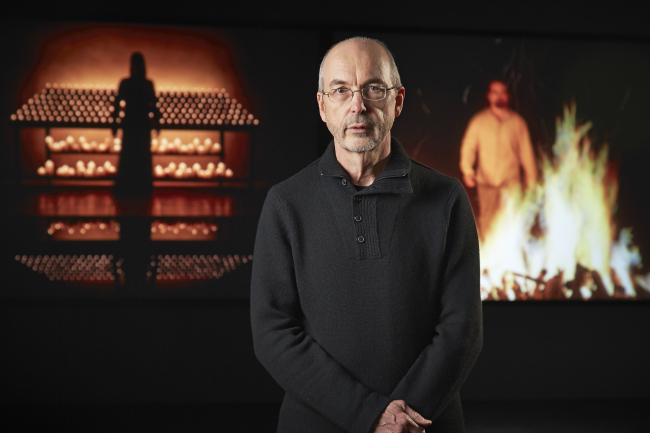Suffering, transformation and redemption
Media artist Bill Viola holds third solo exhibition in Seoul
By Lee Woo-youngPublished : March 10, 2015 - 19:03
Renowned video artist Bill Viola opened his third exhibition in Seoul last week with an unusual introduction.
Against a slow-motion video, he stood and read his journal dated Feb. 4, 1999, about his encounter with an old man at the Getty Museum in Los Angeles. The man, whom he saw as he was entering the gallery, was lying unconscious on the cold museum floor with paramedics pumping his chest.
The background video, meanwhile, showed five people changing their facial emotions so slowly that it almost felt like a still picture.
Against a slow-motion video, he stood and read his journal dated Feb. 4, 1999, about his encounter with an old man at the Getty Museum in Los Angeles. The man, whom he saw as he was entering the gallery, was lying unconscious on the cold museum floor with paramedics pumping his chest.
The background video, meanwhile, showed five people changing their facial emotions so slowly that it almost felt like a still picture.

Viola continued reading the journal, describing how he went inside the museum and viewed his favorite painting, “The Annunciation” by Dieric Bouts.
“Later I came back outside and the man was gone. The stone benches had new people on them, all older, resting. I thought about my father. This is where my work comes from,” he concluded in the brief introduction on Thursday.
The silence that dominates the slow-motion video, the capture of the detailed emotional change in each of the faces and the artist’s personal account of his 1999 visit to the Getty Museum, overall, foretold what the exhibition at Kukje Gallery would present.
The exhibition features seven works, including “Water Martyr,” one of the four pieces in the “Martyrs” series and “Inverted Birth,” an overwhelming video installation towering 5 meters.
Water is a key element in this exhibition as two pieces portray water as the destructive and transformative force. In “Water Martyr,” a man is held upside down by a rope with water cascading over him. The work is one of the four installations showing martyrs tortured by the natural forces caused by earth, air, fire and water. They are currently on permanent exhibit at St. Paul’s Cathedral in London.
“The mass media turns us into witnesses of suffering of others. They also exemplify human pain and even death. This piece represents ideas of action, fortitude, endurance and sacrifice. So martyrs’ past life of action can help us illuminate actions in modern time,” Viola explained, noting the Greek word for martyr meant “witness.”
His use of water can be traced to the near-drowning experience he had when he was 6. Viola said the near-death experience left him with a profoundly beautiful image that he has since been searching for. “I went right to the bottom of a lake and landed on the ground. I saw the most beautiful world I had ever seen,” he said.
Mesmerized by the underwater world, he pushed away his uncle who tried to bring him up.
“That was one of the most important things in my life because the rest of the time I was always going back to the green blue world that’s not on this earth,” he said in the voice of a Zen master.
Water is used as a transformative force in “Inverted Birth” in which a man is deluged and washed by black, red and white fluids and then clear water ― metaphors of man’s transformation from darkness to light.
Some of the spiritual aspects in his works are inspired by his interest in Buddhism and Zen practice. He spent a year and a half with his wife and collaborator of his works Kira Perov in Japan in 1980, practicing meditation under a Zen master.
“What distinguishes Viola’s works from other video artists is the spiritual aspect. Many video artists who started with spiritual elements turn to reality in the end. But Viola still stands on the spiritual side, touching deep parts of viewers,” said art critic Yoo Jin-sang at the gallery.
Viola, who once worked as an assistant to Nam June Paik, incorporates some of the cutting-edge video technologies in order to transfer the spiritual messages into visual images and stop the passing time to give viewers time for meditation.
“Time is probably the most important creation that the world has given us. Time is interesting because it’s going in one direction for all for us,” said Viola. “That’s why we need these technologies, videos and all to understand it and try to realize whether its power can be good or bad.”
The passing of time in Viola’s work is stretched to reach the point where one can’t figure out the original period of time. Viola compares the unattainable flow of time with the infinite cycle of life, quoting the famous quote by Chuang Tzu, “Birth is not a beginning and death is not an end.”
The exhibition runs through May 3 at Kukje Gallery in Jongno, Seoul. For more information, call (02) 735-8449.
By Lee Woo-young (wylee@heraldcorp.com)








![[KH Explains] Hyundai's full hybrid edge to pay off amid slow transition to pure EVs](http://res.heraldm.com/phpwas/restmb_idxmake.php?idx=644&simg=/content/image/2024/04/18/20240418050645_0.jpg&u=20240419100350)






![[From the Scene] Monks, Buddhists hail return of remains of Buddhas](http://res.heraldm.com/phpwas/restmb_idxmake.php?idx=652&simg=/content/image/2024/04/19/20240419050617_0.jpg&u=20240419175937)

![[KH Explains] Hyundai's full hybrid edge to pay off amid slow transition to pure EVs](http://res.heraldm.com/phpwas/restmb_idxmake.php?idx=652&simg=/content/image/2024/04/18/20240418050645_0.jpg&u=20240419100350)

![[Today’s K-pop] Illit drops debut single remix](http://res.heraldm.com/phpwas/restmb_idxmake.php?idx=642&simg=/content/image/2024/04/19/20240419050612_0.jpg&u=)